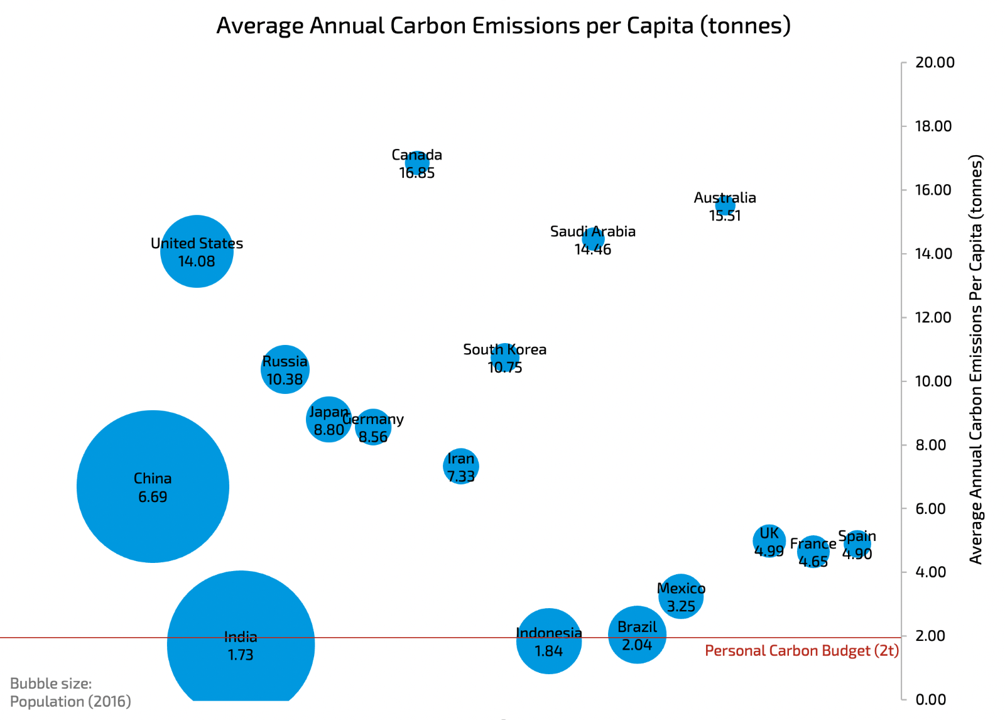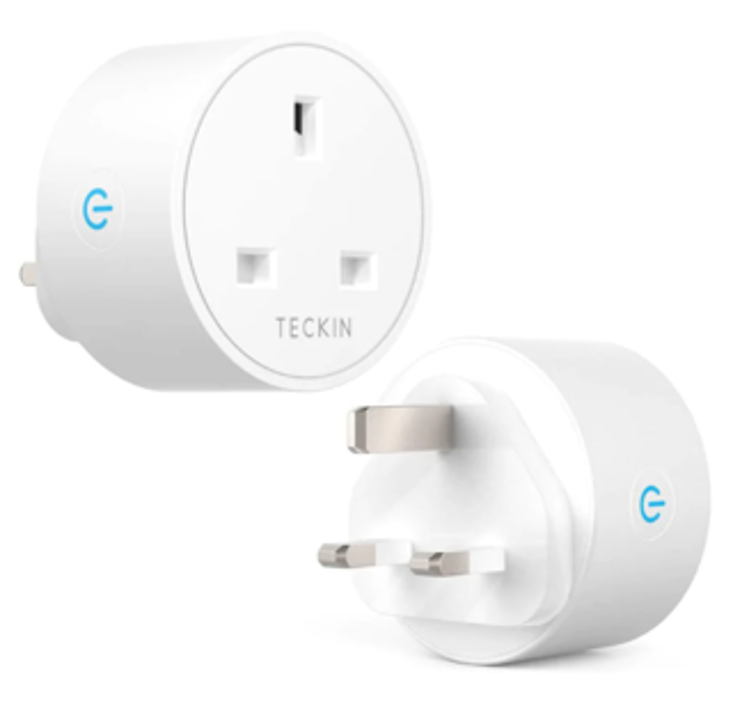Find out about The Open University's Environment courses

Shrinking footprints
Climate change presents humanity with a series of enormous challenges. Unifying these is a single imperative: to avoid catastrophic climate change impacts by capping global temperature rises to 1.5℃.
Achieving this is a monumental challenge, and requires every corporation, government and citizen to make swift, significant changes to our lifestyles – some much more than others.
While nations and industries shoulder the greatest share and responsibility, there is tremendous opportunity for impact from the collective actions of each and every one of us.
To reach this goal, nations, industries and individuals need to cut their carbon footprints to meet much lower annual carbon budgets. On average, we each need to reduce our total carbon footprint to fit within a personal carbon budget of two tonnes per year. This represents an enormous reduction for most developed economies.
As of September 2022, according to Worldometer, current carbon emissions per capita in the UK are 4.99 tonnes, with France at 4.65, Germany 8.56, Spain 4.89 and the United States at 14.08 tonnes.
Among the ten countries responsible for the most carbon emissions, only India and Indonesia are currently below the two-tonne budget, coming in at 1.73 and 1.84 tonnes of carbon emissions per capita per year, respectively.
Shrinking our carbon footprints will take a lot of effort and commitment, but it’s critical for all of us.
 Average annual carbon emissions per capita. Source: Worldometer, September 2022
Average annual carbon emissions per capita. Source: Worldometer, September 2022
Where to start the shrink?
While this can be overwhelming, the good news is that these goals are achievable by adjusting some of our lives and habits.
The biggest chunks of our individual carbon footprints are accounted for in just three categories – housing, travel and food.
Reducing energy consumption required for housing (eg, heating, electricity and cooling), along with cutting travel in diesel or petrol cars, and eating less meat-based foods, will have a big impact on our individual footprints.
But where does the digital carbon footprint fit in with this?
When it comes to our digital carbon footprints, they are a fraction of our total carbon footprint, but there are three reasons why they should not be neglected.
Reason 1: Exponential and incremental
Our collective reliance on and use of digital technologies has been on an exponential growth rate for decades and shows no sign of slowing. The more this continues to grow, the bigger the digital carbon footprint will become.
Reason 2: Cross-cutting
Our digital activities influence and impact our emissions across other categories, including emissions associated with housing and travel.
Reason 3: Empowering
As mentioned in the remote working article (linked below), some of the actions we can take to reduce our personal digital carbon footprints are small, yet impactful. These easier-to-implement actions can help overcome some of the hesitation and hopelessness many experience when trying to comprehend how their individual actions can begin to make a dent in the global challenge, and therefore help move more people onto a trajectory of change.
What can we do as individuals?
Simply put, we need to buy less and use less. Buying less means using our technologies for longer and choosing more sustainable options when acquiring new or replacement items.
Tips for reducing embodied carbon
- Extend the usable lifetime of your technology by exploring upgrade or repair options.
- Find new homes for technology that no longer suits your purpose. Look for opportunities to help others avoid new purchases with your unwanted technology.
- Explore refurbished and remanufactured products, on marketplaces such as Back Market, Reebelo, Cashify and Swappie. Another service, Grover, offers a subscription model to electronics as an alternative to purchasing.
- Big brands are increasingly offering refurbished and remanufactured options, such as Amazon’s Second Chance portal.
- Look for emerging certifications and standards, such as the BSI kitemark for remanufacturing or the Carbon Trust’s Carbon Neutral certification.
 The Carbon Trust’s Carbon Neutral certification, the BSI kitemark for remanufacturing and the Carbon Footprint Standard.
The Carbon Trust’s Carbon Neutral certification, the BSI kitemark for remanufacturing and the Carbon Footprint Standard.
- When the product is beyond use or has no second or third life available to it, choose a circular recycling option for your technology.
- Big brand suppliers are increasingly offering trade-in or technology recycling options. For example:
- Apple offers trade-in and/or recycling depending on your country.
- Amazon provides a recycling service via their Second Chance portal.
- UK retailer Currys offers technology recycling as part of their service.
Adjusting our purchasing behaviours is the single biggest thing we can do for our digital footprint, as well as our carbon footprint more broadly. However, there’s more we can do to lower the carbon emissions associated with our use of technology.
Reducing operational carbon video technology
Technologies that rely on sending video across networks are among the biggest contributors to digital carbon footprints. This is in part due to the amount of data they generate, as well as the energy and equipment required to transmit, store, process and present that data.
With that in mind, cutting back on how we use video is the first place to start in our quest to reduce the carbon emissions we generate when using digital technologies. We can then look for opportunities to reduce unnecessary power consumption by turning things down, or switching them off.
Tips for reducing operational carbon
- Switch off, don't standby: We’ve become accustomed to leaving our gadgets on standby, or in sleep mode. These devices often consume small amounts of power when in these states. Individually the power drain is almost inconsequential, but several devices left on 24 hours a day, 365 days a year will add up to significant levels. For example:
- Unplugging an Amazon Echo overnight could save 3 watts per hour, the equivalent of 8.7 kWh over the year. In today’s energy prices that is almost £4 of wasted electricity from one device that’s not in use, or almost 1.5 kg CO2e.
- Turning off a laptop instead of leaving it in standby could save up to 9 kg CO2e per year.
- Turn down and black out: Turning down default brightness levels on TVs and monitors can significantly cut the amount of power used to run them, while not having much (if any) impact on viewing comfort. For example:
- Reducing the brightness of my BenQ 4K monitor from the factory settings of 95% to 60% prevents 2.6 kg CO2e per year from that one device.
- Choosing ‘Dark Mode’ on smartphones with OLED display technology can save up to a third of the battery, meaning you need to charge it less and therefore make further incremental energy and carbon savings.
- Be heard and not seen: When taking part in video calls, choose to use standard definition video (SD) instead of high-definition, turn down your monitor brightness, and when video isn’t adding value to the call (as is often the case when joining multi-party meetings) turn off video and rely on audio only – even if just for part of the meeting. For example:
- A one hour two-person video call could produce as much as 2.3 kg CO2e, compared to 90g if the call was purely audio.
- Measure, track and experiment: If you have a Smart Meter installed by your energy provider you can try switching things on and off to see how much energy they consume during use and in standby. If you have access to a smart plug* like the one shown below, many have energy consumption metrics built into them that can provide the same insights as a Smart Meter.

More on digital carbon footprints
This resource is part of the Supporting hybrid working and digital transformation collection, made possible by the Higher Educational Funding Council for Wales.








Rate and Review
Rate this article
Review this article
Log into OpenLearn to leave reviews and join in the conversation.
Article reviews